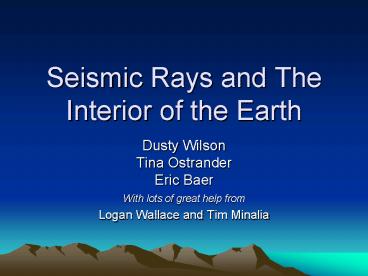Seismic Rays and The Interior of the Earth PowerPoint PPT Presentation
1 / 38
Title: Seismic Rays and The Interior of the Earth
1
Seismic Rays and The Interior of the Earth
- Dusty Wilson
- Tina Ostrander
- Eric Baer
- With lots of great help from
- Logan Wallace and Tim Minalia
2
The Problem
- How do we know what is beneath our feet?
3
How can we find out about the Interior of the
Earth?
- The deepest a human has ever gone
- The deepest well ever drilled
- The deepest a rock has ever been retrieved from
- The center of the Earth
3 km
10 km
250 km
6370 km
4
Seismic Waves
- Formed when earthquakes occur
5
Seismic compression wave velocity
- In air 0.344 km/sec
- In water 1.5 km/sec
- In Jello 4 km/sec
- In glass 4.5 km/sec
- In rocks 7-15 km/sec
6
We can measure the arrival times
7
So, lets use this information
- Could the Earth be entirely made of blue cheese?
- Seismic velocity through blue cheese is 5 km/sec
8
An Earth made of cheese
0
40
80
12760 km
120
150
180
9
An Earth made of cheese
0
40
80
120
150
180
10
Remember, it has to match what we measure!
11
Does it work?
12
Can any work?
- No single velocity
- Upper Earth is slower than deep Earth
5
15
12
10
8
12
13
So what about an Earth with 2 layers?
??
14
Refraction
- When a wave changes speed it bends
- The amount of bending is given by Snells law
Sin (A)
V1
V1
Sin (B)
V2
A
V2
B
15
So what about an Earth with 2 layers?
16
Unfortunately, that does not work either..
- We need more layers!
- Call in the mathematician!
17
Seismic Ray
- a mathematical approach
- Dusty Wilson
18
Mathematical Overview
- A description of the problem
- The mathematics of the solution
- Examples of two models
- Lessons learned for next time
19
A Description of the Problem
- Create an algorithm to model the path of a
seismic ray through a planetary body. - Assume an arbitrary number of layers (or shells)
in the planetary model. - Assume rays travel at a constant velocity through
each layer. - Assume the trajectory of each ray changes as the
ray changes layers, subject to Snells law.
20
The Mathematics
- The mathematics of this project required topics
found at pre calculus level. - The Law of Cosines
- The Quadratic Formula
- Rotation of Axes
21
Law of Cosines
- Law of Cosines
- Solve for C by sub-tracting A2 from both sides of
the equation
22
The Quadratic Formula
- This equation (below) is quadratic in C
- Which can be solved using the quadratic formula
- Do I choose or ?
23
Rotation of Axes
- After the ray travels through the outer layer,
all subsequent paths are determined by an angle
made with a tangent. - This requires a rotation of axes by the angle ?.
24
Definition of a Function
- Does the resultant graph represent a function?
- More importantly What is independent and what is
dependent when it comes to seismic waves.
25
Examples
- Example 1 A model using two layers.
- Example 2 The PREM model which uses 74 layers to
model the Earth.
26
Example 1 A Two Layer Model
- The earthquake takes place at the N. Pole.
- Waves are sent out in all directs at once.
- The model shows individual ray paths but all
begin at the same time. - The waves bend subject to Snells Law
27
Example 1 Angle vs. Time
- The graph shows angle (around the globe) from the
rays start to finish versus the time for the way
to travel through the model. - The discontinuity correlates to the layer
change.
28
Example 2 The PREM Model
- The Preliminary Reference Earth Model (PREM) is a
current model used by geologists to understand
the interior of the Earth - It uses 74 layers to model the physical results
of seismographs.
29
Example 2 Angle vs. Time
- This output from seismic algorithm models the
actual output of seismographs around the world.
30
Lessons Learned
- Mathematics is difficult when the answer is not
in the back of the book - Documentation and prep work is well worth the
time - Mathematics doesnt need to be sophisticated to
pose a serious challenge - Mathematica beautiful yet aggravating
- Challenges lead to excitement (and )
31
Thats all fine and good, but we need something a
student can use!
32
Why We Used Java
- Graphical User Interface (GUI)
- Web based Applets
- Runs in a browser
- Platform Independent
- Can be accessed from anywhere
33
Program Development
Analyze
Document
Debug
Design
Test
Code
34
Converter
InputPanel
Line
RealData
Program Design
LineManager
Display
Graph
35
Code Translation
Mathematica
Java
public static void nextSymAlpha() double
symTheta0 thetaj-1 double v0
velocityWInLayernLayers-j-1 double v1
velocityWInLayernLayers-j double symAlpha1
Math.asin((v1Math.sin((Math.PI/2)-symTheta0))/v
0) alpha appendTo1D(alphaIndex,
symAlpha1, alpha)
36
Before
37
and After!
38
Some final notes
- This project required all of our expertise
- The only place a project like this could happen
is at a community college - Many times we face problems that require
knowledge and expertise from outside of our field - The result is an amazing learning opportunity for
students!
39
Questions?
- Afterwards you are welcome to try the Java program
40
How to use the program
- Turn on a laptop
- Press cntrl-alt-del
- Log on as FRCuser
- No Password
- Log on to (this computer)
- Start seismicGraph document on the desktop (not
the folder)

